What Plants from Nature Can My Rabbits Eat?
Which Are Poisonous?
There are hundreds of wild herbs, but unfortunately, not all of them are suitable for rabbits to eat.
It will certainly take some time until this list is complete—if it ever is. Until then, it can serve as a valuable guide to many plants suitable for rabbit nutrition.
“Mixed in” indicates that these are medicinal plants rather than proper food plants. Medicinal plants should, and will, only be eaten in large quantities when truly necessary, as long as a variety of food is available.
Therefore, they are always just a supplement to regular food plants. Even in a daily mix of meadow plants, medicinal plants should not be missing, so that rabbits have access to these plants when they genuinely need their specific nutrients.
Even the so-called „safe food plants“ should never be fed alone but should always be part of a varied and colorful mix. It’s also crucial to include grasses in every mixture, as all grasses growing in Germany are safe and suitable for rabbits to eat.
Scarlet Pimpernel (Anagallis arvensis)

Not edible, as it is mildly toxic. The roots, in particular, are poisonous.
Field Pennycress (Thlaspi arvense)
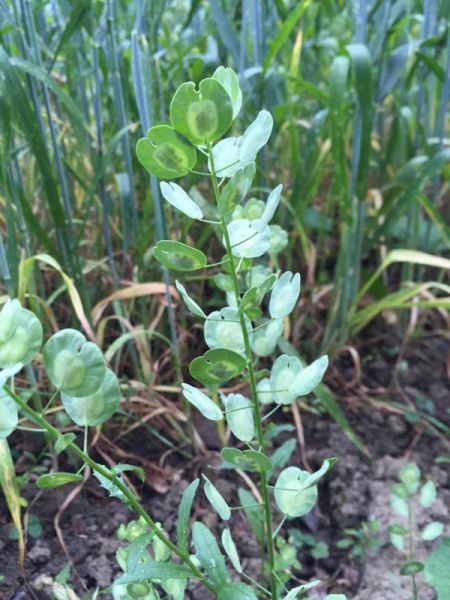
Non-problematic food plant
Field Thistle (Cirsium arvense)

Non-problematic food plant. Rabbits without dental issues can easily grind the thorns.
Field Bugloss, Corn Gromwell, Wolf’s Eye, Hound’s Tongue (Lycopsis arvensis)
Field Bugloss is edible for rabbits. It contains a substance (pyrrolizidine alkaloids) that is toxic to other animals. However, feeding trials with rabbits have shown that they tolerate it well and it does not appear to be toxic to them. See also: Jacob’s Ladder.
Field Horsetail (Equisetum arvense)

Suitable for feeding in a mix. It contains a high amount of silica, which has a positive effect on tooth wear. The confusion with Marsh Horsetail (also edible in a mix) is not problematic for rabbits.
Field Mustard (Sinapis arvensis)

Non-problematic food plant. Some rabbits find it quite tasty.
Field Violet, Wild Pansy, Field Pansy (Viola arvensis)
Non-problematic food plant, beneficial for the respiratory system (contains saponins).
Field Bindweed (Convolvulus arvensis)

Non-problematic food plant. Good for digestive issues. Most rabbits love Field Bindweed.
Bracken (Pteridium aquilinum)
Bracken is toxic to rabbits and should not be fed.
Elecampane (Inula helenium)

Non-problematic food plant. It has antibacterial and anti-inflammatory effects, among other benefits.
Cyclamen
Toxic!
Amaranth (Amaranthus)

Non-problematic food plant. It comes in various cultivated forms, both wild and ornamental. The variety commonly found in gardens, with its striking red flower spikes, is also edible.
Horehound, White Horehound, Common Horehound, Mountain Hop, Motherwort, White Dorant, Marjoram (Marrubium vulgare)
Can be fed well in a mix. Horehound has expectorant properties for respiratory infections and contains the bitter compound marrubiin, which is beneficial for the stomach.
Brazilian Vervain (Verbena bonariensis)

Non-problematic food plant. It is primarily cultivated as an ornamental plant, but it is now also found growing wild.
Arum, Spotted Arum (Arum maculatum)
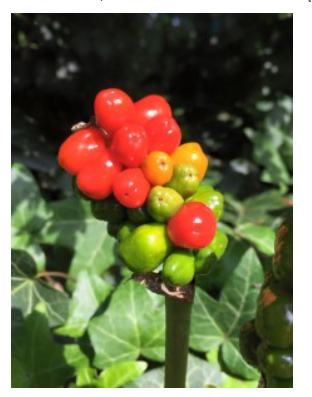
Highly toxic!! Should not be fed to rabbits.
Aster (Aster)
Typically blooms strikingly in autumn, often in shades of white or violet. Very popular with rabbits: a non-problematic food plant.
Water Avens (Geum rivale)

Non-problematic food plant. Moisture-loving plant.
Valerian (Valeriana officinalis)

Can be fed well in a mix. Valerian often grows in moist areas.
Wintercress, Yellow Rocket (Barbarea vulgaris)

4
Non-problematic food plant.
Wild Liquorice (Astragalus glycyphyllos)

Non-problematic food plant. Quite unknown, despite being an excellent food plant. Rabbits absolutely love the leaves, which is no surprise since they have a mildly sweet taste.
Wild Garlic (Allium ursinum)

Should always be fed in a mix with other plants. There is a risk of confusion with highly toxic plants like Lily of the Valley, Arum, and Autumn Crocus. A characteristic feature of wild garlic is its garlic-like smell. Wild garlic is eaten to prevent intestinal parasites and to strengthen the immune system.
Masterwort (Meum athamanticum)

Bastard Campion (Silene x hampeana)
Non-problematic food plant. Often eaten with enjoyment.
Hairy Bittercress (Cardamine hirsuta)
Non-problematic food plant. Contains glucosinolates, which can help with respiratory and kidney diseases.
Mugwort (Artemisia vulgaris)

Can be fed in a mix. A great herb for the stomach and intestines. A good identifying feature is the silvery underside of the leaves.
Comfrey (Symphytum officinale)

Can be fed well in a mix. Many rabbits do not like comfrey. There is a risk of confusion with the highly toxic foxglove (similar leaves).
Annual Fleabane (Erigeron annuus)

Non-problematic food plant.
Bee Friend (Phacelia tanacetifolia)

See Phacelia.
Bittersweet Nightshade (Solanum dulcamara)

Highly toxic!
Purple Loosestrife (Lythrum salicaria)
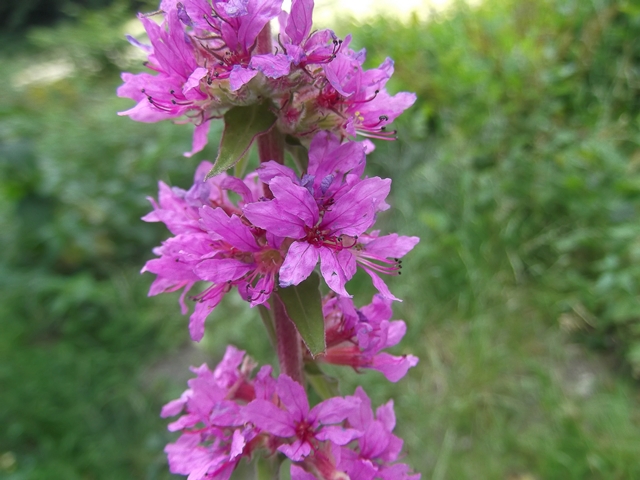
Non-problematic food plant. Commonly found near bodies of water or other moist areas
Goatsbeard (Tragopogon)

Non-problematic food plant.
Borage (Borago officinalis)
Can be fed well in a mix. It is commonly known as a kitchen herb, which is why it grows in many gardens. However, borage can also be found growing wild in some areas. There is a risk of confusion with the highly toxic foxglove (similar leaves)!
Selfheal (Prunella)

Non-problematic food plant.
Broadleaf Cattail (Typha latifolia)

Can be fed in a mix. Grows in many ponds, lakes, and similar environments. This species is not protected like other cattail species.
Greater Plantain (Plantago major)

Non-problematic food plant. It has anti-inflammatory properties, among other benefits.
Nettle (Urtica)

Non-problematic food plant. Rabbits prefer it dried or wilted; otherwise, it stings. For this reason, it can be easily dried for winter use. Nettle has many medicinal properties, such as being diuretic and blood-cleansing. Do not touch it without gloves, as it can cause a burning rash!
Watercress (Nasturtium officinale)

4
Can be fed well in a mix. Found in moist areas, such as streams.
Buckwheat (Fagopyrum esculentum)

The plant itself is a non-problematic food plant. The gluten-free seeds should only be given as a treat.
Crown Vetch (Securigera varia)

Non-problematic food plant. Unlike vetches (Vicia), it lacks a terminal tendril, making it easy to distinguish between the two similar plants even before flowering.
Lacy Phacelia (Phacelia tanacetifolia)

See Phacelia.
Oregano; Wild Oregano (Origanum vulgare)

Non-problematic food plant. Helpful for coccidiosis.
Sweet violet (Viola odorata)

Non-problematic food plant. Many rabbits find it quite tasty.
Lady’s bedstraw (Galium verum)

Non-problematic food plant. Has anti-inflammatory properties, among other benefits.
Touch-me-not balsam (Impatiens noli-tangere)

Can be fed as part of a mix. Usually not particularly popular.
English ivy, Common ivy (Hedera helix)
Medicinal plant. Can occasionally be fed in small amounts as part of a mix. Ideal for respiratory conditions. The berries are toxic.
Vervain (Verbena officinalis)

Non-problematic food plant.
Speedwell (Veronica)
Field speedwell (Veronica arvensis), Ground-ivy speedwell (Veronica chamaedrys), Persian speedwell (Veronica persica), Thyme-leaved speedwell (Veronica serpyllifolia)

Non-problematic food plant. There are many species of speedwell, all of which look quite different. However, the blue flowers are easily recognizable in the wild versions. Some variants bloom more in white or pinkish colors. All of them are equally edible.
One-berry (Paris quadrifolia)

Toxic!
Angelica (Angelica archangelica)

Non-problematic food plant. Wear gloves when picking (meadow dermatitis).
Barren strawberry (Potentilla sterilis)

Non-problematic food plant. Can be confused with wild strawberry. However, both are equally safe to eat.
Fumitory (Fumaria officinalis)

Fumitory can be offered as part of a mix.
Scotch thistle (Onopordum acanthium)

Non-problematic food plant. Rabbits can easily chew the thorns without any dental issues.
Sainfoin (Onobrychis viciifolia)

Non-problematic food plant.
Suckling clover (Trifolium dubium)

Non-problematic food plant.
Dyer’s weld (Reseda luteola)

Non-problematic food plant. Often grows on fallow land.
Field clover (Trifolium campestre)

Non-problematic food plant. Do not feed together with commercial dry food, such as pellets.
Lamb’s lettuce (Valerianella locusta)

Non-problematic food plant, which, to the surprise of many owners, can also be found in the wild. Only the basal leaves resemble the lamb’s lettuce from the supermarket. Once it blooms, it looks different.
Orpine, Purple Stonecrop (Hylotelephium telephium)

Non-problematic food plant.
Foxglove (Digitalis purpurea)

Highly toxic!
Cornflower (Centaurea), Greater knapweed (Centaurea jacea), Common cornflower
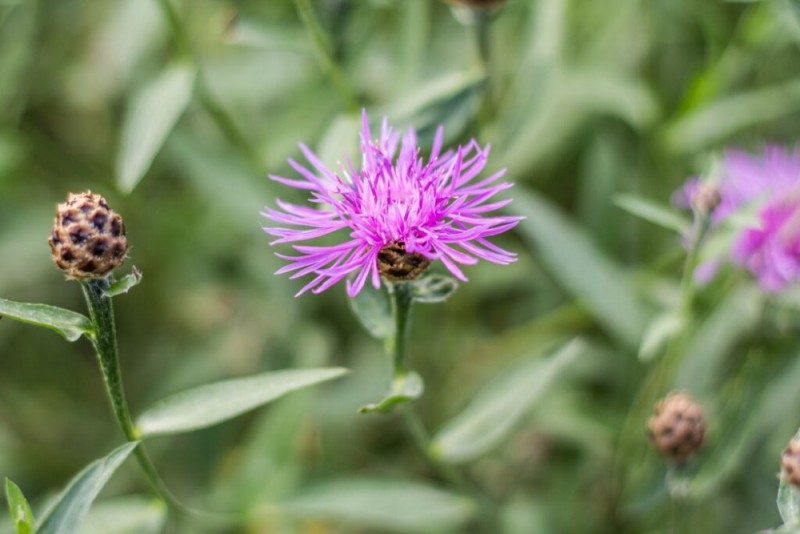
Non-problematic food plant. There are many species, but all are safe to feed.
Spotted Knotweed

Can be fed as part of a mix. Often well-liked
Gallant Soldier (Galinsoga quadriradiata) and Smallflower Galinsoga (Galinsoga parviflora)

See Buttonweed
Lady’s Mantle (Alchemilla)

A trouble-free forage plant. It has, among other benefits, antispasmodic properties. Lady’s Mantle is also commonly found as a perennial in gardens.
Spring Vetchling (Lathyrus vernus)

An unproblematic forage plant. Often liked by rabbits.
Cinquefoil; Creeping Cinquefoil (Potentilla reptans), Silver Cinquefoil (Potentilla argentea)

Unproblematic forage plant
Fodder pea (Vicia sativa)

Unproblematic forage plant. Often very popular
Daisy (Bellis perennis)

Unproblematic forage plant.
Sow thistle, Common (Sonchus oleraceus)

Unproblematic forage plant. Very popular with rabbits. The sow thistle species in the photo can also be picked easily without gloves.
Goosegrass (Potentilla anserina)

Unproblematic forage plant. It has, among other benefits, antispasmodic and blood-purifying effects. Silver-colored underside of the leaves, or completely silver.
Spotted Lungwort (Pulmonaria officinalis)

Unproblematic forage plant. It has wound-healing properties. It is often not liked by rabbits.
Spotted Hemlock (Conium maculatum)

Highly toxic!
Ground Elder (Aegopodium podagraria)
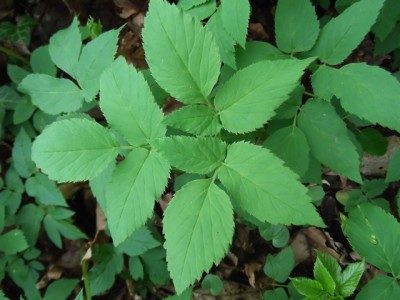
Unproblematic forage plant. Very popular with rabbits. Ground elder prefers shady areas. Identification should be based on the leaves, not the flowers, to avoid confusion with toxic umbellifers
Apple of Peru, Blue Groundcherry (Nicandra physalodes)
Typically found in gardens, but has also become naturalized in some areas; toxic!
Yellow Loosestrife (Lysimachia vulgaris)

Unproblematic forage plant. Rather unpopular with rabbits. Often found growing prolifically in gardens.
Yellow Archangel (Lamium galeobdolon)

Unproblematic forage plant. Often grows as a ground cover in shady areas.
Hoary Cress (Berteroa incana)
Unproblematic forage plant. Often only conditionally liked by rabbits.
Große Sternmiere (Stellaria holostea), Gras-Sternmiere (Stellaria graminea), Wasser-Sternmiere (Stellaria aquatica) in English: Greater Stitchwort (Stellaria holostea), Grass Stitchwort (Stellaria graminea), Water Stitchwort (Stellaria aquatica).

Unproblematic forage plant. Usually very popular. As the name suggests, Grass Stitchwort is often overlooked in the grass.
Ground Ivy (Glechoma hederacea)

Edible in a mix, usually only consumed as a medicinal plant. A good digestive herb.
Bugle (Ajuga), Creeping Bugle (Ajuga reptans)

Unproblematic forage plant. Has antibacterial properties, among others.
Hawkweed (Hieracium)

Unproblematic forage plant. There are several different species of hawkweed, so the individual species can look slightly different. The photo shows the Mouse-ear Hawkweed (Hieracium pilosella).
Buttercup (Ranunculus), Creeping Buttercup (Ranunculus repens), Meadow Buttercup (Ranunculus acris)
Buttercups are found in almost every meadow and are noticeable due to their yellow flowers. They are mildly toxic and should not be fed deliberately. Rabbits tend to avoid them, and if consumed in small amounts as part of mixed forage, they are harmless. There is a risk of confusing them with the highly toxic Monkshood and Delphinium!
Wood Loosestrife (Lysimachia nemorum)
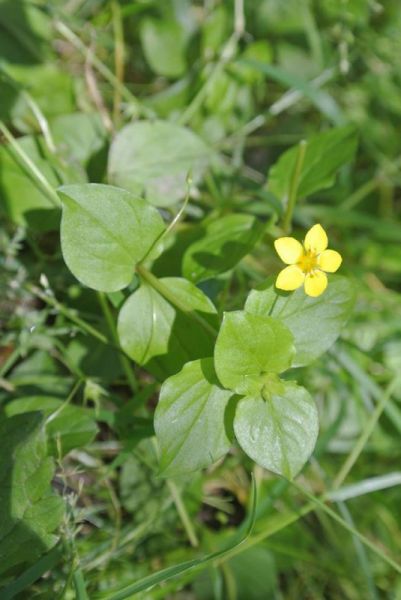
Unproblematic forage plant.
Restharrow (Ononis)

Unproblematic forage plant.
Hare’s-foot Clover (Trifolium arvense)

Unproblematic forage plant.
Hedge Woundwort, Tumble Woundwort (Chaerophyllum temulum)
The hedge woundwort is toxic to rabbits. See umbellifers & co.
Heather (Calluna vulgaris)
Heather is an unproblematic forage plant but is often not particularly liked.
Motherwort (Leonurus cardiaca)

Unproblematic forage plant. Has, among other benefits, antispasmodic properties.
Enchanter’s Nightshade (Circaea lutetiana)

Edible in a mix, high oxalic acid content. Grows well in forests.
Shepherd’s Purse (Capsella bursa-pastoris)

Unproblematic forage plant. Pregnant animals should only receive small amounts, as it has labor-inducing effects in large quantities.
Hemp-nettle (Galeopsis)

Unproblematic forage plant. Often rather unpopular.
Hop, Common Hop (Humulus lupulus)

Unproblematic forage plant. Has antibacterial and germicidal properties, among others. Tends to climb extensively.
Black Medick (Medicago lupulina)

Unproblematic forage plant. Do not feed if commercial dry food, such as pellets, is being fed.
Tall Cinquefoil (Potentilla recta)

Unproblematic forage plant
Bird’s-foot Trefoil (Lotus corniculatus)

Unproblematic forage plant. Do not feed if commercial dry food, such as pellets, is being fed.
Mouse-ear Chickweed, Spring Mouse-ear Chickweed (Cerastium fontanum)
4

Unproblematic forage plant. Mouse-ear chickweed is easily overlooked in the grass, as it grows very close to the ground.
Horned Violet (Viola cornuta)

Unproblematic forage plant. There are various flower colors.
Coltsfoot (Tussilago farfara)

Edible in a mix. Has, among other properties, expectorant effects. Easily recognizable by the whitish, hairy underside of the leaves.
Fool’s Parsley (Aethusa cynapium)

Fool’s Parsley is toxic to rabbits. See Umbellifers & Co.
Indian Balsam (Impatiens glandulifera)

Edible in a mix. Often unpopular. Grows prolifically in forests, is an invasive non-native plant.
Periwinkle, Lesser Periwinkle (Vinca minor)
Toxic! Safe in garden enclosures.
Crimson Clover (Trifolium incarnatum)

Unproblematic forage plant. Do not feed together with commercial dry food, such as pellets.
Common Ragwort (Senecio jacobaea; Syn.: Jacobaea vulgaris Gaertn.)

Common ragwort is edible for rabbits, as it contains a substance (pyrrolizidine alkaloids) that is toxic to other animals. In feeding trials with rabbits, it was found that they tolerate it well and it does not have toxic effects. See Common Ragwort.
St. John’s Wort (Hypericum)
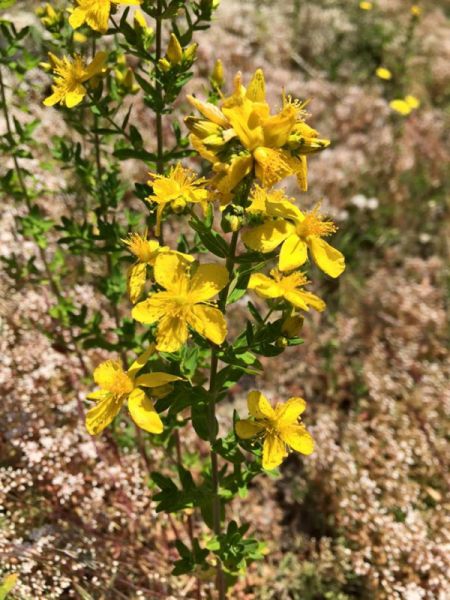
Unproblematic forage plant. Some rabbits really enjoy it. Do not feed it daily or in large amounts to albino or white animals if they have access to direct sunlight, as the hypericin it contains can make them sensitive to sunlight. When handling, wear gloves, as exposure to sunlight can cause a rash in humans.
Chamomile (Matricaria)

Non-toxic forage plant. Whether it’s true chamomile, corn chamomile (rayless), or scentless mayweed.
Canadian Goldenrod (Solidago canadensis)

Non-toxic forage plant. Among other effects, it acts as a diuretic.
Canadian Fleabane (Conyza canadensis)

Non-toxic forage plant. Very inconspicuous in appearance. Prefers fallow areas.
Caucasian Stonecrop (Phedimus spurius)

Non-toxic forage plant. This plant is typically found in gardens but can also be encountered in the wild, for example, on dry grasslands or walls.
Common Poppy (Papaver rhoeas)

Well-suited for feeding in mixtures. The leaves are palatable to many rabbits.
Small-flowered Willowherb (Epilobium parviflorum)

Non-toxic forage plant. Among other effects, it has anti-inflammatory properties.
Burdock; Woolly, Greater, Lesser (Arctium)

Non-toxic forage plant. Often not very popular.
Cleavers (Galium aparine)

Non-toxic forage plant. Moderately popular with most rabbits. Cleavers can be easily recognized by its sticky nature, as it clings to clothing, fur, and other surfaces.
Garlic Mustard (Alliaria petiolata)

Non-toxic forage plant. Often unpopular due to its garlic-like smell.
Galinsoga (Galinsoga quadriradiata; Galinsoga parviflora)
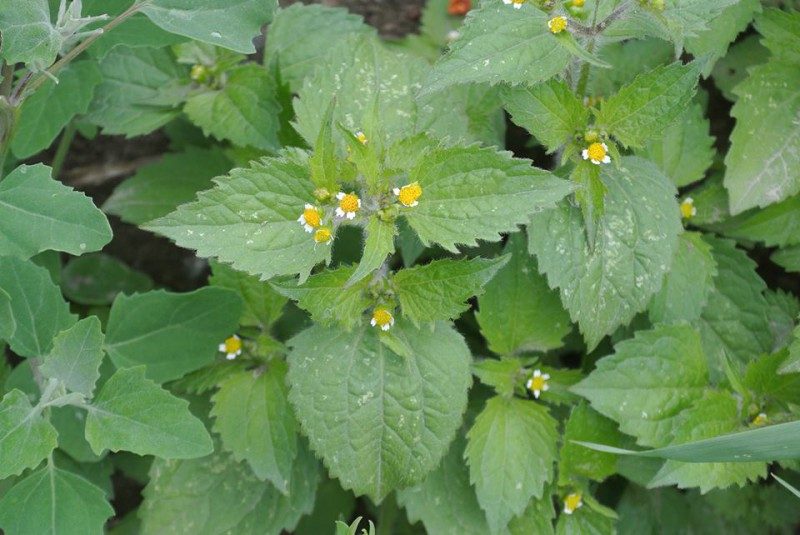
Non-toxic forage plant. Usually very popular with rabbits. Rich in vitamin C.
Knotty Figwort (Scrophularia nodosa)

Not edible
Mullein (Verbascum)

Non-toxic forage plant. Often not very popular. There is a risk of confusion with the highly toxic foxglove (Digitalis)!
Compass Lettuce (Lactuca serriola)

An unproblematic forage plant. Very popular with most rabbits. It can be easily recognized by the spines on the leaf ribs on the underside of the leaves. The leaves also grow quite vertically upwards.
Cornflower (Centaurea cyanus)
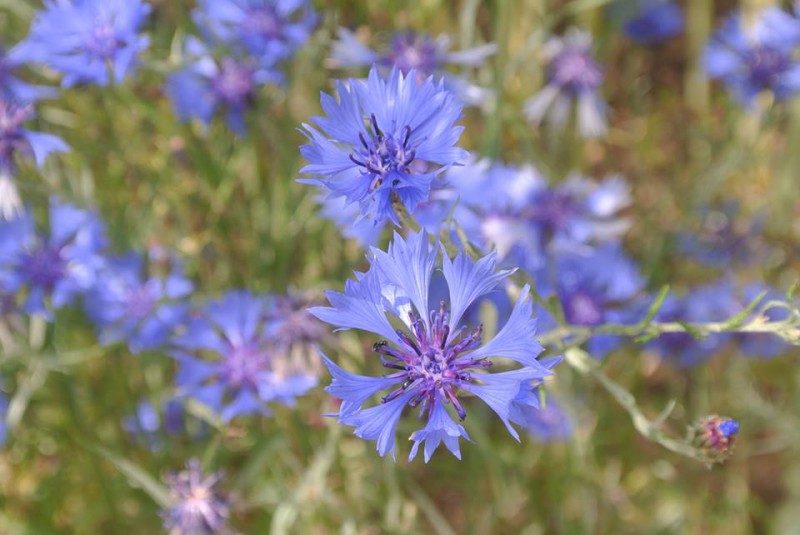
An unproblematic forage plant. Often found near fields. Good for the digestive tract and also has anti-inflammatory effects there.
Thistle (Cirsium)

An unproblematic forage plant. The many thorns often discourage rabbit owners from collecting them. However, rabbits sometimes quite like thistles. Rabbits without dental problems can easily grind the thorns with their teeth.
Ragged Robin (Lychnis flos-cuculi)
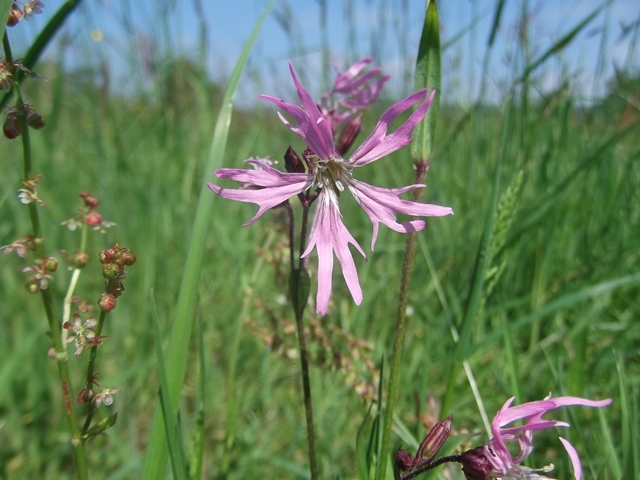
An unproblematic forage plant. Often not very popular.
Globe Thistle (Echinops)
It also occurs wild; an unproblematic forage plant.
Common Toadflax (Linaria vulgaris)

Unproblematic forage plant.
Corydalis (Corydalis cava)

Toxic!
Dandelion (Taraxacum)

An unproblematic forage plant. Almost everyone knows it, as dandelion is ‚the typical rabbit food‘.
Alfalfa (Medicago sativa)

The fresh plant is an unproblematic feed. However, when dried, it should be fed only occasionally due to its high calcium content.
Meadowsweet (Filipendula)

An unproblematic forage plant. Has pain-relieving effects.
Oxeye Daisy (Leucanthemum vulgare)

An unproblematic forage plant. It is also called the meadow fleabane.
Lily of the Valley (Convallaria majalis)

Toxic!
Mallow; Musk Mallow, Common Mallow, Wild Mallow, and others (Malva)

Unproblematic forage plants. They have anti-inflammatory effects, among others.
Wall Lettuce (Mycelis muralis)
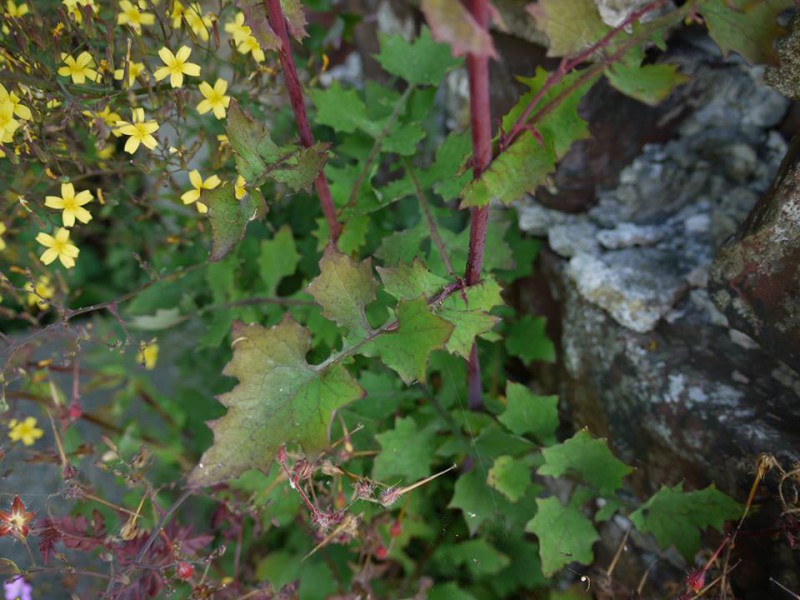
Unproblematic forage plant. Commonly found in shady places.
Horseradish (Armoracia rusticana).
4

Unproblematic forage plant. Has anti-inflammatory effects, among others. It can have both divided and undivided leaves.
S
Sea Kale (Crambe maritima)

Unproblematic forage plant. Found along the coasts of the North and Baltic Seas.
Star-of-Bethlehem; Umbellate (Ornithogalum umbellatum)
Slightly toxic!
Alternate-leaved Golden Saxifrage (Chrysosplenium alternifolium)

Unproblematic forage plant. Good for spleen diseases, as the name suggests.
Medium Clover (Trifolium medium)

Unproblematic forage plant. Do not feed with commercial dry food, such as pellets. Very popular with rabbits.
Evening Primrose (Oenothera biennis)

Unproblematic forage plant. The bright yellow flowers stand out very well on summer evenings.
Black Nightshade (Solanum nigrum)
It forms small, round black berries after flowering; highly toxic!
Viper’s Bugloss (Echium vulgare)

Can be fed in a mix. Often not very popular. However, bees and bumblebees love the flowers of Viper’s Bugloss.
Narcissus (Daffodil)

Not edible. It occurs both wild and as a cultivated plant.
Wood Avens (Geum urbanum)

Unproblematic forage plant. Prefers to grow in shady areas.
Nettle-leaved Bellflower (Campanula trachelium)

An unproblematic fodder plant, the Nettle-leaved Bellflower (Campanula trachelium) somewhat resembles the stinging nettle (Urtica dioica) when not in bloom, leading some to confuse the two species. However, once the violet flowers emerge, it becomes easy to distinguish between the two plants.
Agrimony (Agrimonia eupatoria)

An unproblematic fodder plant, Common Agrimony (Agrimonia eupatoria) is often mistaken for Silverweed (Potentilla anserina). However, Agrimony lacks the silvery underside of the leaves that is characteristic of Silverweed.
Orange Hawkweed (Hieracium aurantiacum)

Unproblematic plant.
Turkish Warty Cabbage or Hill Mustard (Bunias orientalis)

Unproblematic fodder plant. It is also an introduced neophyte, which is why many would appreciate it being used as feed—similar to Japanese Knotweed.
Parsnip (Pastinaca sativa)
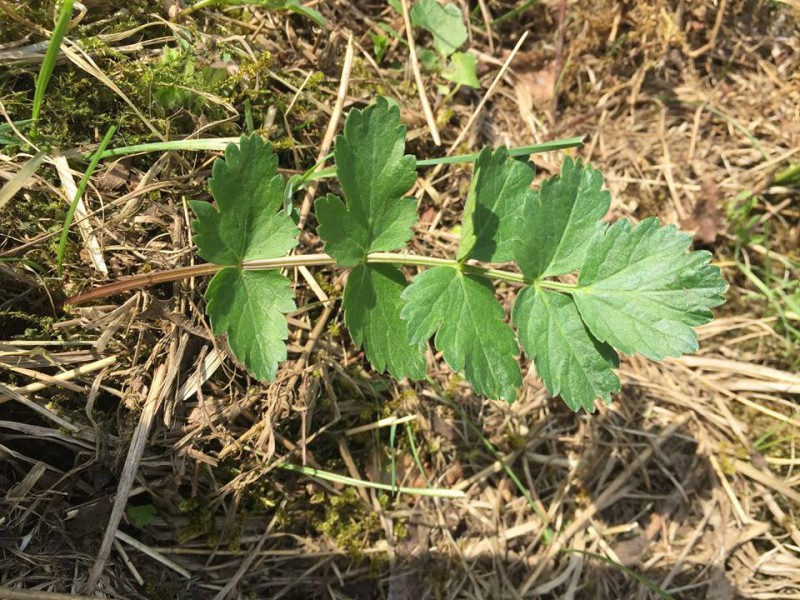
Unproblematic fodder plant. Wear gloves when picking (Pastinaca sativa) to avoid grass dermatitis.
Persian Clover (Trifolium resupinatum).

Unproblematic fodder plant. Do not feed in combination with pellets or other commercial dry feed (pellets).
Butterbur (Petasites hybridus).

Edible in a mixture. It was used in the Middle Ages to treat the plague, which is how it got its name. Rabbits with digestive problems may sometimes eat it. Like coltsfoot, it first produces a flower in the spring, but this one is white or reddish and has many small flowers on a flower stalk.
Perennial Pepperweed (Lepidium draba).
Unproblematic fodder plant.
Moneywort (Lysimachia nummularia)

Unproblematic fodder plant. It spreads over the ground.
Tansy Phacelia (Phacelia tanacetifolia)

Unproblematic fodder plant. It is often planted in gardens for bees or used as a cover crop for soil improvement in fields.
Salad Burnet (Sanguisorba minor)
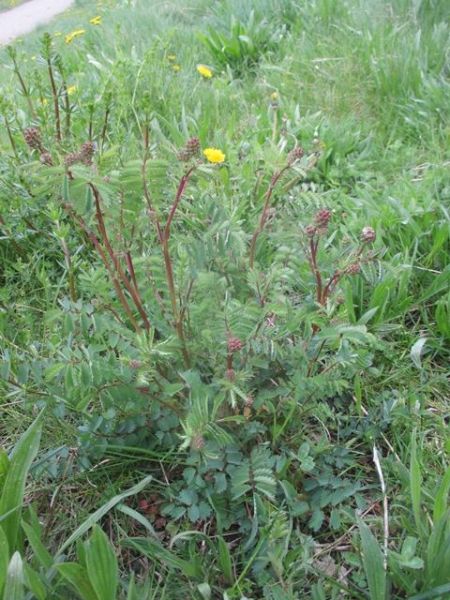
Unproblematic fodder plant. Also known as Greater Burnet.
Vetchling or Pea (Lathyrus)

Unproblematic fodder plant. In gardens, Platterbse (Lathyrus) is often known as Sweet Pea or Edelwicke. It usually blooms in pink, but there are cultivated varieties with white flowers, among others.
Pyramidal Bugle (Ajuga pyramidalis)

Unproblematic fodder plant. It is used as a medicinal plant for treating wounds.
Tansy (Tanacetum vulgare)

Edible as a medicinal plant in a mixture. It is often consumed to help prevent intestinal parasites.
Rapeseed (Brassica napus)

Unproblematic fodder plant. Most rabbits love the young leaves.
Heron’s Bill (Erodium cicutarium)

Unproblematic fodder plant.
4
Giant Hogweed (Heracleum mantegazzianum)

Unproblematic fodder plant for rabbits. However, humans should avoid contact with it. Wear gloves when picking, just like with stinging nettles. In combination with UV radiation, it can cause severe blistering on the skin. Never handle it without thick gloves.
Marigold (Calendula officinalis)

Unproblematic fodder plant.
Red Campion (Silene dioica)

Unproblematic fodder plant. It is often happily eaten by animals.
Red Clover (Trifolium pratense)

Unproblematic fodder plant. It is good for diarrhea. Do not feed it in combination with commercial dry feed, such as pellets.
Common Sorrel (Rumex acetosa)

Edible in a mixture. It contains a high amount of oxalic acid, so it should be fed in a mixture. Some types of sorrel have a leaf shape similar to the highly toxic Arum (Jack-in-the-pulpit), but sorrel grows in meadows, while Arum grows in shrubs or forests (shaded areas) as a ground cover.
European wood sorrel (Oxalis stricta)

Can be fed well in mixtures. Due to its oxalic acid content, it should only be fed as part of a mixture.
Yarrow (Achillea millefolium)

Unproblematic fodder plant. It is not an umbellifer, as one might think, but rather a member of the aster family, like dandelions. It typically blooms white, though it can also have pale pink or fully pink flowers.
Lesser celandine (Ranunculus ficaria)

Can be fed as part of a mixture. A typical plant in spring. From May onwards, the leaves die back in preparation for the next spring.
Bistort (Bistorta officinalis)

Unproblematic fodder plant. Effective for diarrhea.
Russian vine (Fallopia baldschuanica)

Unproblematic fodder plant. Loves to climb fences and similar structures.
Primrose, Tall Primrose (Primula elatior)
Edible in a mixed form, but it is under nature protection and therefore cannot be collected!
Narrow-leaved Ragwort (Senecio inaequidens)
This is edible for rabbits; however, it contains a substance (pyrrolizidine alkaloids) that is toxic to other animals. Feeding trials with rabbits have shown that they tolerate it well and it does not appear to be toxic. See Jacob’s ladder.
Narrow-leaved Vetch (Vicia angustifolia)

A non-problematic forage plant.
Narrow-leaved Willowherb (Epilobium angustifolium)

A non-problematic forage plant. It is usually not very popular with rabbits.
Snowdrop (Galanthus)

Not edible, but harmless in a garden free-range.
Chives (Allium schoenoprasum)
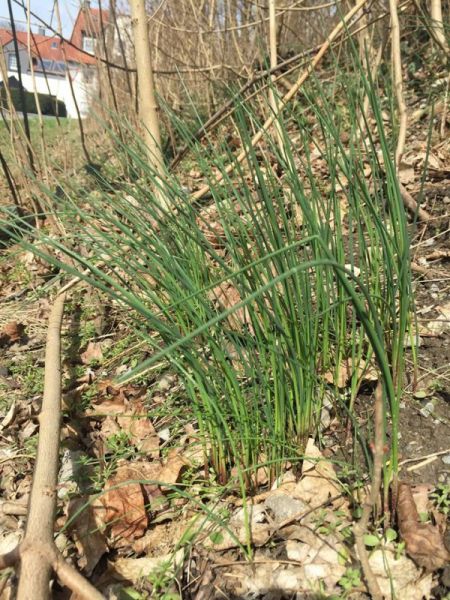
Edible in a mixed form. It is eaten to help prevent intestinal parasites. Chives also grow wild in nature.
Greater Celandine (Chelidonium majus)

In a good mix, the leaves are edible. The yellow/orange plant sap is a good identifying feature, but it is toxic. Rabbits usually prefer the young leaves. Other parts of the plant are toxic.
Sweet Lupine
A non-problematic forage plant. It is less commonly found growing wild, but it is often cultivated as a forage crop. There is a risk of confusion with the highly toxic monkshood (Aconitum) and delphinium (Delphinium)! Always ensure proper identification before offering plants to animals.
Black Nightshade (Solanum nigrum)

Highly toxic!
Swedish Clover (Trifolium hybridum)

A non-problematic forage plant. It should not be fed with commercial dry food, such as pellets.
Soapwort (Saponaria officinalis)

Edible in a mixed form.
Sickle Clover (Medicago sativa L. subsp. falcata)

A non-problematic forage plant. Should not be fed with commercial dry food, such as pellets.
Silverleaf, Annual Silverleaf (Lunaria annua)
A non-problematic forage plant, but the seeds are toxic. The large, silver pods after flowering are a distinctive feature. It is important to avoid feeding the seeds to animals, as they can be harmful.
Sunflower (Helianthus annuus)

A non-problematic forage plant. However, the seeds should only be given as treats, as they are high in fat.
Sunspurge (Euphorbia helioscopia)

Not a forage plant, but mildly toxic!
Asparagus (Asparagus)

A non-problematic forage plant. It also grows wild. The greenery is quite inconspicuous and can be easily overlooked.
Ribwort Plantain (Plantago lanceolata)

A non-problematic forage plant. It has soothing properties, including being expectorant. The plant sap also cools mosquito bites for the owner. The parallel plant fibers make it easily identifiable.
Flickerweed (Cardamine impatiens)

A non-problematic forage plant. It prefers to grow in shady spots.
Japanese Knotweed (Fallopia japonica)

A non-problematic forage plant, like the other knotweed species. Most rabbits prefer it dried, so it can also be easily dried for winter feeding.
Sweet Clover (Melilotus)

Edible in a mixed form. It has healing properties, including wound healing. Should not be fed with commercial dry food, such as pellets.
Hollyhock (Alcea rosea)
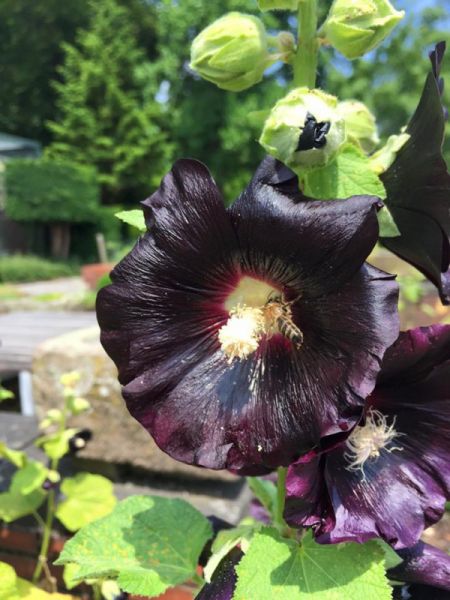
A non-problematic forage plant. It comes in many different flower colors. It is commonly found in gardens, but it is now also growing wild in some areas.
Cranesbill (Geranium)

A non-problematic forage plant. There are many different species, all with varying appearances. Most bloom in pink, but blue- or white-flowered varieties are also known. The leaf shape varies depending on the species. Some varieties are mainly planted in gardens, while others are wild plants. All are edible. However, there is a risk of confusion with the highly toxic monkshood (Aconitum) and delphinium (Delphinium)! Always ensure proper identification to avoid any potential hazards.
Broad-leaved Dock (Rumex obtusifolius)

Edible in a mixed form, due to its high oxalic acid content.
Marsh Woundwort (Stachys palustris)

A non-problematic forage plant. It has antispasmodic properties.
Sweet Cicely (Myrrhis odorata)

A very good forage plant, but there is a risk of confusion with highly toxic umbelliferous plants!
Bladder Campion (Silene vulgaris)

A non-problematic forage plant. Some rabbits enjoy eating it. It is also commonly found in seed mixes for gardens.
Pigeon Flower (Scabiosa columbaria)

A non-problematic forage plant. It closely resembles the Widow’s Flower (Knautia arvensis). A mix-up is not dramatic, as both are safe to eat.
Deadnettle; white, red, round-leaved, spotted (Lamium)

A non-problematic forage plant, but it is generally unpopular.
Miner’s Lettuce (Claytonia perfoliata)

A non-problematic forage plant. It can also be found in winter at organic stores under the name „Postelein.“
Thyme (Thymus pulegioides)

A non-problematic forage plant. Wild thyme prefers dry locations.
Water Bugle (Lycopus europaeus)
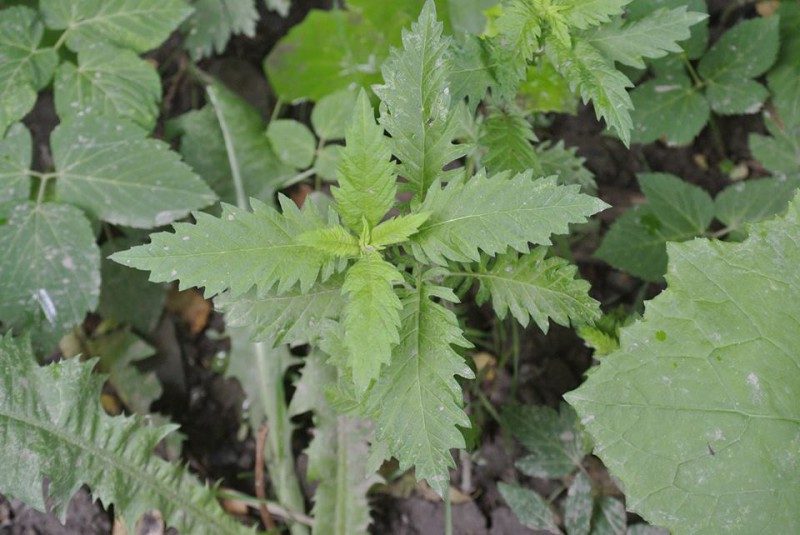
A non-problematic forage plant. Often found near bodies of water or other damp areas.
Forget-me-not (Myosotis), Marsh Forget-me-not (Myosotis scorpioides), Wood Forget-me-not (Myosotis sylvatica)

Should always be offered in a mix. Some rabbits find the leaves quite tasty. There are also pink or white-flowering varieties that are planted in gardens. These are also safe to include in the mix.
Common Knotweed (Polygonum aviculare)

The Common Knotweed (Polygonum aviculare) is an unproblematic forage plant that is beneficial for digestive issues. Some rabbits absolutely love it.
Common Chickweed (Stellaria media)

The Common Chickweed (Stellaria media) is an unproblematic forage plant, often very popular among animals. In winter, it can be found in sheltered spots, such as under bushes or hedges, even during snow and frost.
Tufted Vetch (Vicia cracca)
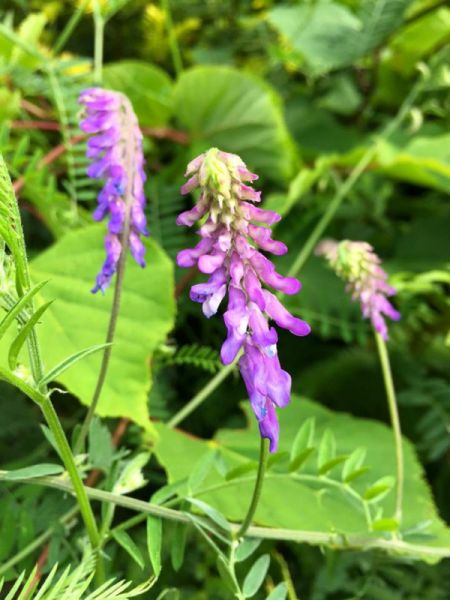
The Tufted Vetch (Vicia cracca) is an unproblematic forage plant that is often confused with the Hairy Vetch (Vicia villosa), which is also safe to eat. However, the Hairy Vetch is covered in hairs, while the Tufted Vetch is smooth and hairless.
Common Cow-wheat (Melampyrum pratense)

Slightly toxic
Wood Strawberry (Fragaria vesca)

Unproblematic forage plant. Rich in tannins, good for digestion.
Woodruff (Galium odoratum)

Can be fed in a mix – due to the contained coumarin. However, some rabbits absolutely love woodruff. With its distinctive white flowers and carpet-like spreading, it catches the eye of many people in spring.
Wood Sorrel (Oxalis acetosella)

Can be fed in a mix, due to its high oxalic acid content.
Wood Violet (Viola reichenbachiana)
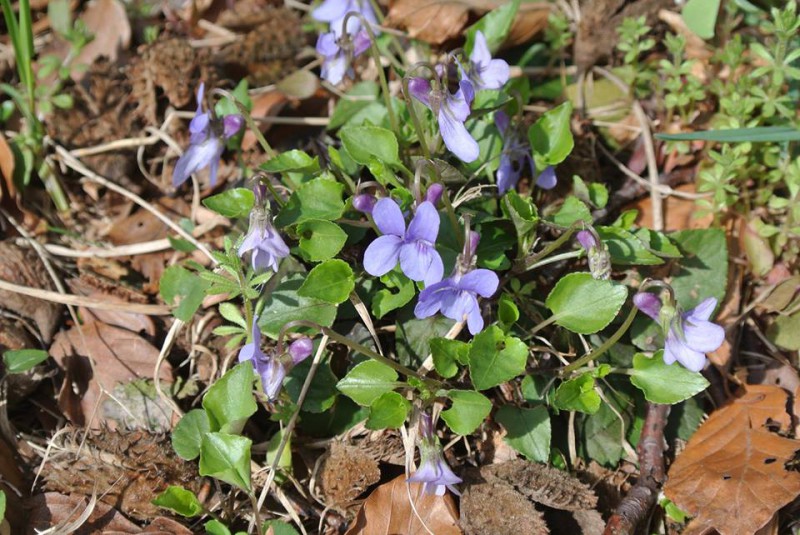
Unproblematic forage plant. Many rabbits find it quite tasty.
Wood Betony (Stachys sylvatica)

Unproblematic forage plant. A characteristic of the Wood Betony (Stachys sylvatica) is its unpleasant smell. It has antispasmodic effects.
Hemp Agrimony (Eupatorium cannabinum)

Can be fed in a mix. As the name suggests, it prefers moist areas, but can also be found in relatively dry spots.
Water Mint (Mentha aquatica)

Unproblematic forage plant. As the name suggests, it is found near bodies of water.
Common Yellow Rocket (Sisymbrium officinale)

Unproblematic forage plant.
Chicory (Cichorium intybus)

Unproblematic forage plant. The leaves are inconspicuous and closely resemble those of dandelions, but the bright blue flowers are immediately noticeable.
White Campion (Silene alba)
Is an unproblematic forage plant. It is generally well-liked.
White Goosefoot (Chenopodium album)

Unproblematic forage plant. Often very popular with rabbits. It is one of the first plants to colonize new areas, such as construction sites.
White Clover (Trifolium repens)

Unproblematic forage plant. Not to be fed with commercial dry foods, such as pellets.
Cow Parsley (Anthriscus sylvestris)
Is an excellent forage plant. However, it can be confused with other members of the Apiaceae family, so care should be taken (see „Umbellifers & Co.“).
Common Cow Parsnip (Heracleum sphondylium)

Unproblematic forage plant. It should definitely be included in the diet as long as it is available. A truly great herb for rabbits that they enjoy eating. Cow Parsnip helps against E. Cuniculi. There is a risk of confusion with toxic umbellifers when identifying it by its flowers.
Meadow Bedstraw (Galium mollugo)

Unproblematic forage plant.
Meadow Vetchling (Lathyrus pratensis)

Unproblematic forage plant. Very popular with rabbits. Often grows inconspicuously in tall grass.
Meadow Sage (Salvia pratensis)

Unproblematic forage plant. It has antibacterial properties, among other benefits.
Cuckoo Flower (Cardamine pratensis)

Unproblematic forage plant.
Wild Teasel (Dipsacus fullonum)

Unproblematic forage plant. Not always liked.
Wild Carrot (Daucus carota subsp. carota)

Unproblematic forage plant. The leaves are very popular with rabbits, similar to carrot tops. There is a risk of confusion with highly toxic umbellifers, see „Umbellifers & Co.“
Wood Anemone (Anemone nemorosa), Yellow Anemone (Anemone ranunculoides), and Balkan Anemone (Anemone blanda) are toxic plants and should not be fed to animals.
Winter Aconite (Eranthis hyemalis)

Not edible
Field Scabious (Knautia arvensis)

Unproblematic forage plant.
Lamb’s Ear (Stachys byzantina)

Unproblematic forage plant. It is also known as Hare’s Ear.
Woundwort (Anthyllis vulneraria)

Unproblematic forage plant. It has healing and disinfectant properties, among others. The photo shows a red cultivated variety, while wild Woundwort blooms yellow.
Hedge Bindweed (Vicia sepium) is an unproblematic forage plant
Hedge Bindweed (Calystegia sepium)

Unproblematic forage plant. Good for digestive issues. Most rabbits love Hedge Bindweed
Ivy-leaved Toadflax (Cymbalaria muralis)

Unproblematic forage plant. Ivy-leaved Toadflax (Cymbalaria muralis) is often found in stone walls.
Hairy Vetch (Vicia villosa) is an unproblematic forage plant.
Hairy Willowherb (Epilobium hirsutum) and Narrow-leaved Willowherb (Epilobium angustifolium)

Unproblematic forage plant. It prefers to grow in damp areas.
Cypress Spurge (Euphorbia cyparissias)

Toxic!




















